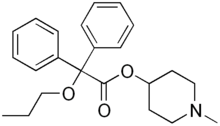 | |
| Clinical data | |
|---|---|
| AHFS/Drugs.com | International Drug Names |
| ATC code | |
| Legal status | |
| Legal status | |
| Pharmacokinetic data | |
| Elimination half-life | 20.1 h |
| Identifiers | |
| |
| CAS Number |
|
| PubChem CID | |
| ChemSpider | |
| UNII |
|
| CompTox Dashboard (EPA) | |
| Chemical and physical data | |
| Formula | C23H29NO3 |
| Molar mass | 367.489 g·mol−1 |
| 3D model (JSmol) | |
| |
| |
| | |
Propiverine is an anticholinergic drug used for the treatment of urinary urgency, frequency and urge incontinence, all symptoms of overactive bladder syndrome.[2][3] It is a muscarinic antagonist.[4]
- ^ "Digestive and bladder health". Health Canada. 9 May 2018. Retrieved 13 April 2024.
- ^ McKeage K (January 2013). "Propiverine: a review of its use in the treatment of adults and children with overactive bladder associated with idiopathic or neurogenic detrusor overactivity, and in men with lower urinary tract symptoms". Clinical Drug Investigation. 33 (1): 71–91. doi:10.1007/s40261-012-0046-9. PMID 23288694. S2CID 3399082.
- ^ Huang W, Zong H, Zhou X, Wang T, Zhang Y (December 2015). "Efficacy and Safety of Propiverine Hydrochloride for Overactive Bladder in Adult: a Systematic Review and Meta-analysis". The Indian Journal of Surgery. 77 (Suppl 3): 1369–1377. doi:10.1007/s12262-015-1264-1. PMC 4775592. PMID 27011567.
- ^ BNF 61. London: British Medical Journal Group and Pharmaceutical Press. March 2011. p. 511. ISBN 978-0-85369-962-0.